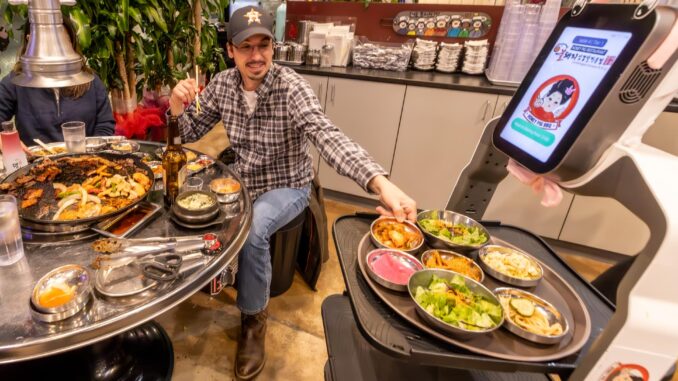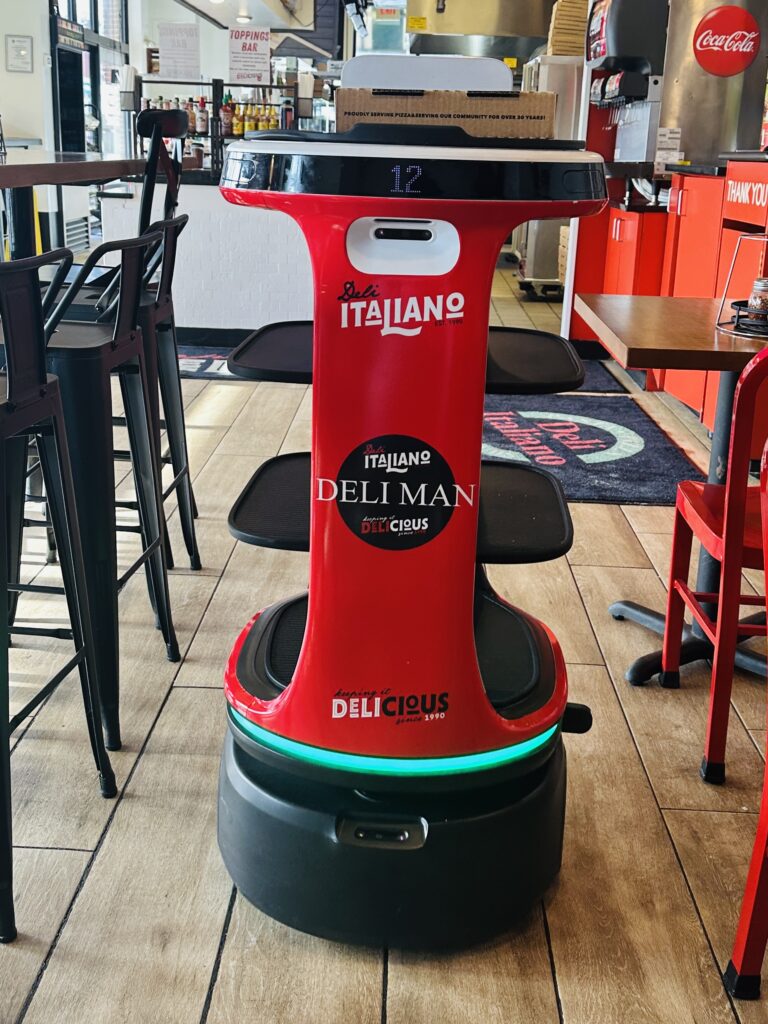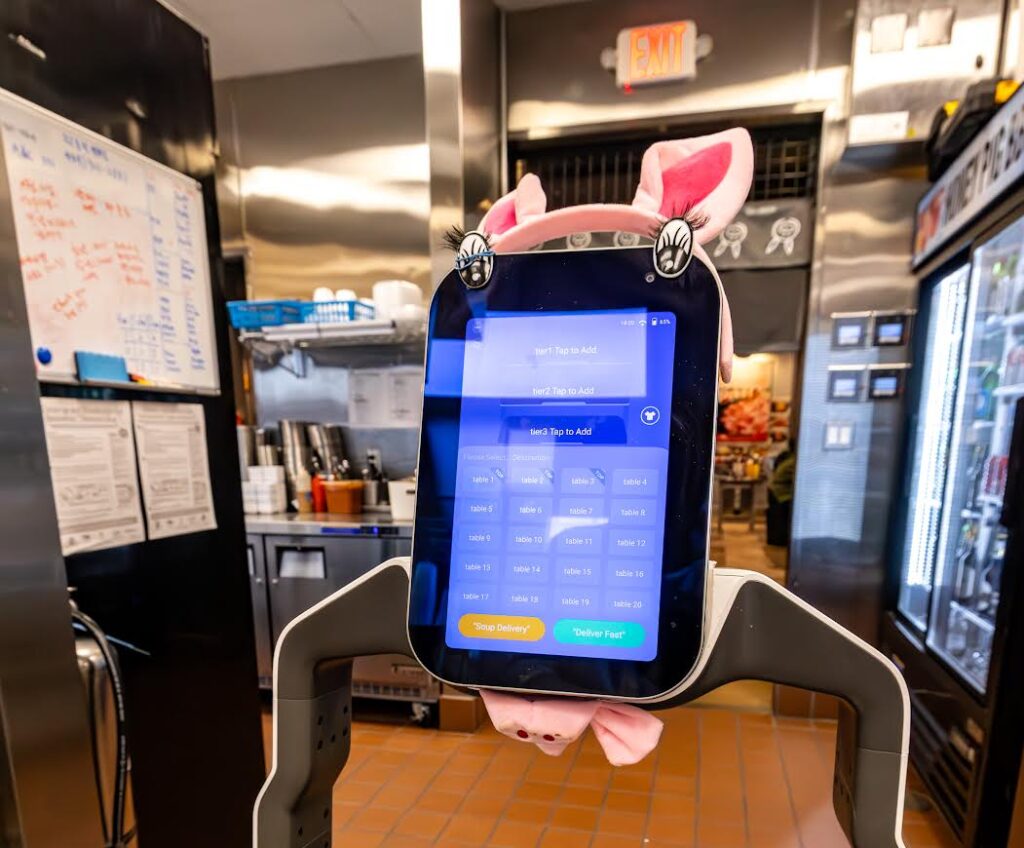
RISE OF THE ROBOTS
By Chris Wadsworth
Most of us have probably seen the “Terminator” movies. We knew the age of robots was coming – but who would have thought they would be so darn cute? That’s the word Brandy Schaefer uses to describe the robot servers at the Honey Pig Korean BBQ restaurant in the Ashburn Farm Market Center.
“I think it was on our second or third visit when we first saw them,” Schaefer said. “They have little pig ears on top and a little pig tail behind them.”
Schaefer and her husband, Gary, who live in Ashburn’s Village of Waxpool neighborhood, love Honey Pig. They go several times a month, more if their kids are home from college, and order dishes like beef bulgogi, beef brisket, pork belly and marinated chicken.
“The robot delivers the raw meat from the kitchen directly to your table,” Schaefer said. “[Then] the employee removes the meat from the robot and puts it on the grill at your table. It’s a neat concept.”
Honey Pig is just one of several Ashburn area restaurants to add robot servers to their dining rooms.
Up at the Deli Italiano restaurant in the Lansdowne Town Center, customers are entertained – and served – by the Deli Man.
“We wanted to do something different and make our customers remember the visit,” said owner Yasser Baslios, who drives around in a car with a license plate that reads DELI MAN.
The Deli Man robot has four levels in order to carry piping hot pizzas, plates of pasta and savory sub sandwiches out to the dining room. The staff loads the robot up, enters the table numbers and Deli Man rolls around delivering the food. A ticket taped to each level with the customer’s name on it lets them know which food is theirs.
These robot servers emit a soft chime as they move about to make people aware of them, and they have sensors that can detect if a person or object is blocking their path. When that happens, the robots are programmed to backup and find a different route.
The robots even have the ability to speak to customers. Deli Man greets customers in English and in Spanish and says things such as “Your delicious meal has arrived” and “Enjoy your food.” It can also sing “Happy Birthday” and during the holidays, it wishes customers a “Merry Christmas.”
If Deli Man gets stuck between people for too long and can’t move, it very politely says the following: “Well, this is awkward. My boss is watching. Please excuse me. I don’t want to lose my job.”
Robots in restaurants can be used for other things too besides delivering food. They can seat guests and help with bussing tables – delivering dirty dishes right to the dishwasher. Restaurant brands such as Chick-fil-A, Chipotle, Wendy’s and Sweetgreen have all experimented with robots at some of their stores.
Worldwide, robots have been infiltrating restaurants for some time now – especially in Asia where acceptance of new technology is high. Robots in kitchens cook French fries and flip burgers. More advanced robots are even preparing coffee drinks and cocktails.
As you can imagine, a food-carrying, song-singing robot draws a lot of attention. That’s another big reason why some restaurants are adopting them. Not only do they legitimately help out with the workload, but they are also a great marketing tool.
“Our restaurants are meant to stimulate all of your senses, with the music and cooking your own food. The robot really does add a new element of entertainment,” said Hanna Embree-Lowry, the director of marketing and business development for Honey Pig. “At first we thought it was kind of slow – our servers move faster – but having this robot moving across the restaurant – people really do get a kick out of them.”
Indeed, owners say that many customers take videos and photos of the robot servers that wind up on social media – free publicity for the restaurant.
So, are robots taking jobs away from people? Well, perhaps. Or perhaps not. Across the country and right here in Ashburn, many restaurants are struggling to hire enough staff.
“These days one of our biggest worries is staffing. That’s one of the hardest things for all restaurants,” said Embree-Lowry.
Honey Pig has 12 stores currently with three more in the works. They have added robot servers to about 75% of their locations. They have found that the robot servers help “tremendously” with staffing by eliminating a role they had on each shift called a “food runner.”
The service team at Honey Pig locations also pools its tips, Embree-Lowry explained, but they don’t have to share with the robot. “Having fewer people on the schedule means everyone gets a bigger cut of the pooled tips.”
Robot servers aren’t cheap. While prices vary, they tend to cost around $15,000 per unit.
Bhaskar Burra is the owner of AllGoRhythms, a restaurant and dance club near the Dulles Town Center shopping mall in Sterling. He added two robot servers to his team in December. One runs food to customers’ tables. The other is programmed to operate in “patrol” mode, and it carries around hors d’oeuvres at private parties.
Burra pays $1,000 a month for the two units via a lease program. He says people enjoy them, and he views it primarily as a marketing tool right now versus a huge boon to his service.
“For the price, I expected a little more,” Burra said. “They are like a self-driving car. They still have some basic issues.”
Indeed, robots also are not always the perfect solution. Restaurants with steps, outdoor patios, and other physical challenges will prove too much for the current crop of servers that rely on wheels and smooth floors.
In 2020, the Chili’s Grill & Bar chain famously introduced a robot named Rita and expanded it to roughly 60 of its locations before pausing the program. Among the issues cited: The robots moved too slowly and got in the way of human employees, and a majority of customers didn’t think it improved the overall experience.
In the long run, there will always be a section of the restaurant industry – certainly your more upscale and refined dining experiences – that relies entirely on the human touch and real-life hosts, servers and bartenders.
But not all restaurants require that – and the economics may be on the side of the robots. While the cost of human labor will continue to rise, the costs associated with robot technology – just like computers, cell phones and DVD players before them – will almost certainly fall.
“I first worked with robots in restaurants about eight years ago,” Burra recalled. “They could only go on a fixed path and if something small – like a dropped spoon – was in their path, they would get stuck. So, the technology is improving. They are getting smarter and smarter, and they save costs for businesses – so they will always have a place in restaurants.”



